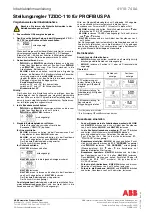
Page 5
AVAILABLE FORCES
Force developed by the double-acting cylinder is determined by multiplying the applied air pressure by the exposed
piston area.
Pounds of force (retracted stroke) = applied pressure (psi) x 2.2 inches
Pounds of force (extended stroke) = applied pressure (psi) x 2.4 inches
On either of the two single-acting, spring-returned models, spring force must be considered in determining force
developed by the cylinder at different points in the stroke. On extended stroke:
Pounds of force = applied pressure (psi) x 2.4 inches
Minus pounds of spring force
The accompanying graph shows pressure in psi required to overcome the force of the spring as the piston rod is
extended. Opposing spring force increases as the stroke length of the piston rod increases and the spring is further
compressed. From the graph, pounds of spring force can be determined by multiplying the pressure (psi) by the
piston area. Thus, the initial force of the cylinder at zero stroke is:
Pounds of force (model code P -057638-00000) = applied pressure (psi) x 2.4 inches
Minus (20 psi x 2.4 inches)
Pounds of force (model code P -058994-00000) = applied pressure (psi) x 2.4 inches
Minus (16 psi x 2.4 inches)
For spring force at subsequent piston rod positions on extended stroke, project across the graph from the
appropriate stroke length point on the vertical line until the pressure line is intersected. Project down from this point
to arrive at pressure in psi. Multiply this figure by the 2.4 inches of piston area.
On retracted stroke, only spring force is available.
PISTON AREA:
PRESSURE - PSI
EXTENDED = 2.4”
RETRACTED = 2.2”










